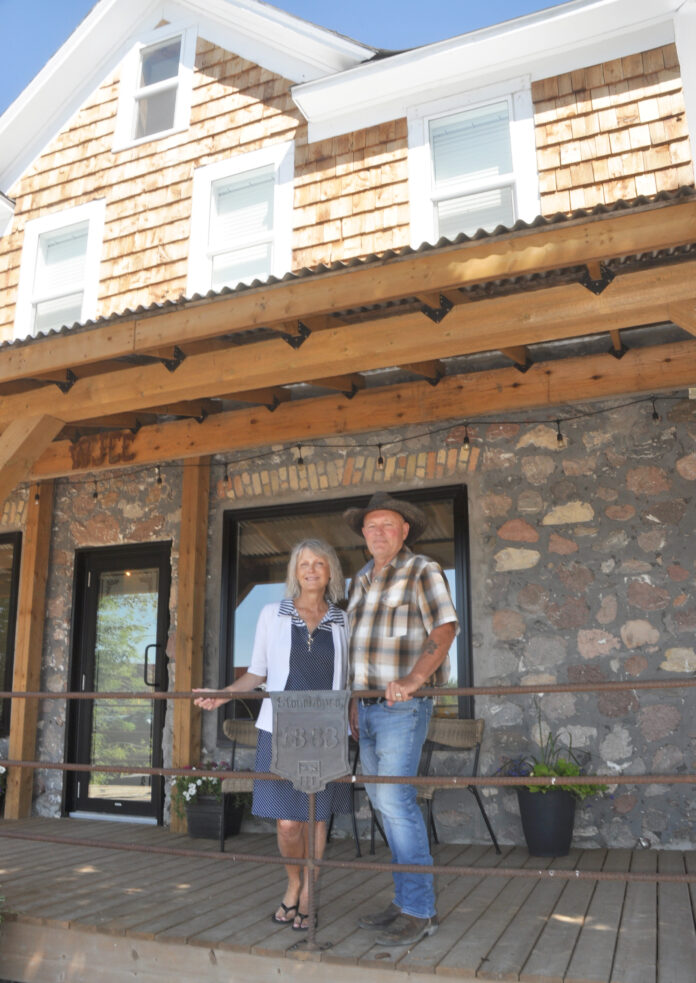MATTHEW LIEBENBERG
FOR THE SOUTHWEST BOOSTER
An important piece of Swift Current’s architectural heritage has been completely renovated through the efforts of Swift Current business owner Lawrence Carr.
The building at 435 North Railway Street East, at the corner of 5th Avenue NE, dates from 1883.
It is one of the oldest surviving structures from those early years of the community’s history.
“I’m glad I did it,” he said. “It just fits into something that we should be doing. That to me is something that’s part of everybody’s heritage here, not just mine. It’s part of our history and we don’t want to see that go.”
An open house on July 26 gave city residents an opportunity to take a closer look at the building after the renovation.
“I think it was a good turnout,” he said. “I just wanted to have it, if anybody was interested to come, because lots of people go by and say I’d like to see that.”
Some of the open house visitors had a connection to the building through family members who lived there or because they personally lived in it.
The building was used as a residential property and it became a rooming house at some time.
One of the visitors at the open house was Alistair “Bud” McEwan, who was five years old in the late 1930s when his older sister Margaret stayed upstairs in the building.
“This sidewalk out here was made of CPR cinders and I’d come along on my tricycle,” he recalled. “My sister would be waiting here, saying come on in. I remember going up the stairs to where she resided on the second floor and have lemonade or something, and visit with my sister.”
He walked up those same stairs to look at the renovated upstairs area, which is now a furnished residential space with a loft.
“It’s been renovated quite a bit, but I can still remember the bedroom there that my nephew and I used to go in and sit there,” he said.
He is happy that the building, which stood empty and in disrepair for several years, has been renovated.
“I used to drive by here on the street and I felt broken-hearted to see the way it was going downhill, but now with the new renovations it looks much better,” he said.
Carrie and Doug Lanigan from Powell River in British Columbia also came to the open house. They were in Swift Current to visit McEwan and he wanted to show them where Margaret lived.
Margaret stayed in this building until about 1940 and her son Jim Proud, who is Carrie’s father, was born in 1936. He therefore also lived in this building.
Carrie was interested to see the building where her 86-year-old father and her grandmother, who passed away in 1993, lived while they were in Swift Current.
“It’s amazing to see that the building is still here, and to have this renovated,” she said. “It’s really nice.”
Carr purchased the building in May 2017 and began the time-consuming process of renovating the structure.
“There was just a lot of work,” he said. “So we went at it from time to time as we could and then came up with a plan of how I wanted to do it and went forth from there.”
He estimated the building stood empty for close to 10 years before he purchased it. A previous owner obtained a demolition permit in 2012, but he did not go ahead with his plan to destroy it. One of the unique features of the building probably helped to save it from the wrecking ball. It was originally constructed as a single-storey building with fieldstone exterior walls, and those thick walls probably made the demolition of the structure too expensive.
Carr gathered as much information as he could about the building’s history. It was apparently constructed by advanced survey crews of the Canadian Pacific Railway and used as a residence for surveyors as well as a headquarters in the region. The second floor was added later, probably in 1906.
Ownership of the building changed several times in the period after 1900. Records indicate there were seven different owners from 1904 to 1944.
At one time it became one of Swift Current’s earliest opera halls. Dean Sawtelle, a local merchant, purchased the building in 1911. He was influential in the local cultural community and made the building available for theatre groups and opera performances.
Sawtelle died in 1918 and the property was sold to a Mr. J. Ramstell of New Brunswick.
It was around this time period that the building was used by the RCMP. Carr was able to find a historic photograph of the building with the name of the RCMP above the door entrance to the second floor. It is suspected that the building was used by the North-West Mounted Police, based on local folklore, but no documentary evidence has been found so far.
However, some old bullets were found in the yard when the area was scanned with a metal detector. It is the same calibre than the ammunition used by the North-West Mounted Police.
The fieldstone walls, wood floors and brick chimney are original elements of the building. There were various challenges during the renovation due to the age of the structure and the many alterations made to the interior over the years.
Continued on Page 3
“The biggest challenge was trying to figure out what to do to improve the inside look and make it functionable, and to fill in the stonework on the inside,” he said. “A lot of stuff had to be done to secure the stonework around all the windows and door openings.”
Carr previously carried out another renovation project in the city after he purchased the historic Royal Bank of Canada building on Central Avenue North, which was built in 1913.
The renovated space in the old bank building is leased out and the same will happen in the newly renovated building on North Railway Street East. The main floor is available for commercial rental as an office space and the upstairs area is a furnished residential space.
His wife, Monica, took care of all the interior decoration details for the residential space. They prefer to offer it as a fully furnished unit.
“We decided to rather do that,” he said. “I didn’t really want people moving in and out, and banging stuff up. So we just made the decision it would be easier and better for us if we furnished it.”
A noticeable addition to the building is a covered porch, which was done for functional and aesthetic reasons. It provides added weather protection and screens the large front windows against the heat of the sun. It also gives some added dimension to the square shape of the original structure.
“The porch is a whole separate structure,” he noted. “It’s never been drilled into the building. So if I want to put it back to exactly the way it was, you can take all that down and it never hurts the house.”






